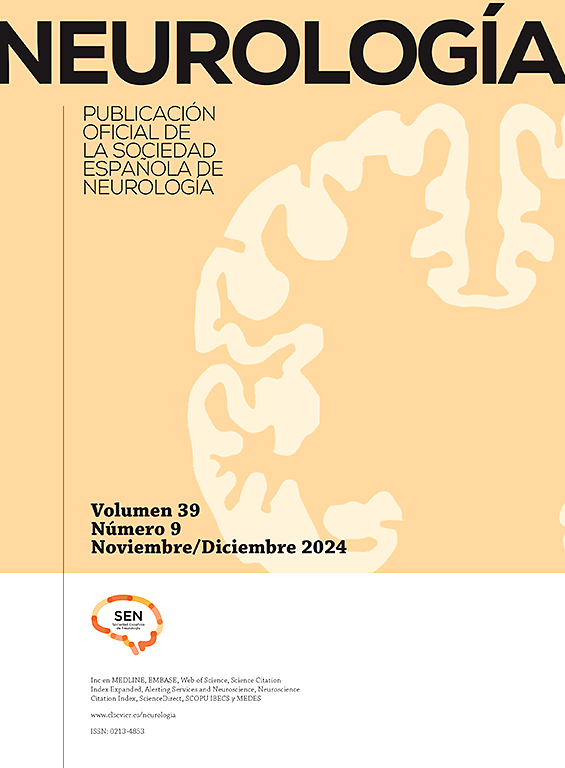Manejo actual de las crisis epilépticas urgentes en un hospital de tercer nivel de la Comunidad de Madrid, estudio descriptivo
IF 3.1
4区 医学
Q2 CLINICAL NEUROLOGY
引用次数: 0
Abstract
Objective
Analyse the current status of the management of urgent epileptic seizures (ES) in a tertiary referral hospital in the Community of Madrid at each stage of the care process and by the different medical teams involved, including out-of-hospital emergency services, hospital emergency departments and neurology teams.
Method
Cross-sectional descriptive study with a subsequent 30-day prospective longitudinal follow-up of a consecutive sample of patients with urgent EC, recruited between October 2021 and March 2022.
Results
Fifty-three patients were included. The mean age was 57.6 (21.2) years. 39.6% were women. 35.8% had a previous diagnosis of epilepsy. The most frequent cause of urgent ES was high-risk seizures (57%), followed by status epilepticus (24%) and cluster seizures (19%). A total of 90.5% of the seizures occurred in the out-of-hospital setting. The median time between ES and emergency services assessment was 40 (27–78) min, and between ES and neurology assessment 165 (97.5–290) min. 86.8% were treated with benzodiazepines and 81.1% with at least one anti-crisis medication. Urgent video-EEG monitoring was performed in 60.4%. The most frequent destination after emergency management was hospital discharge (47.2%), followed by hospitalisation (39.6%). At 30 days, 20.8% of patients had a new ES and 5.7% had died.
Conclusions
Analysis of the current state of emergency EC management shows significant delays at all levels, both in assessment and drug administration.
马德里社区三级医院紧急癫痫危机的当前管理,描述性研究
目的分析马德里社区某三级转诊医院急诊癫痫发作(ES)在护理过程各阶段的管理现状,以及不同医疗团队(包括院外急诊、医院急诊科和神经内科团队)的管理现状。方法横断面描述性研究,随后对2021年10月至2022年3月期间招募的紧急EC患者连续样本进行30天前瞻性纵向随访。结果纳入53例患者。平均年龄为57.6(21.2)岁。39.6%为女性。35.8%有癫痫病史。紧急ES最常见的原因是高危癫痫发作(57%),其次是癫痫持续状态(24%)和丛集性癫痫发作(19%)。总共90.5%的癫痫发作发生在院外。ES与急救服务评估之间的中位时间为40(27-78)分钟,ES与神经学评估之间的中位时间为165(97.5-290)分钟。86.8%的患者接受苯二氮卓类药物治疗,81.1%至少接受一种抗危机药物治疗。60.4%的患者进行了紧急视频脑电图监测。急诊处理后最常见的目的地是出院(47.2%),其次是住院(39.6%)。30天时,20.8%的患者发生了新的ES, 5.7%的患者死亡。结论对急诊EC管理现状的分析显示,各级在评估和给药方面都存在明显的延误。
本文章由计算机程序翻译,如有差异,请以英文原文为准。
求助全文
约1分钟内获得全文
求助全文
来源期刊

Neurologia
医学-临床神经学
CiteScore
5.90
自引率
2.60%
发文量
135
审稿时长
48 days
期刊介绍:
Neurología es la revista oficial de la Sociedad Española de Neurología y publica, desde 1986 contribuciones científicas en el campo de la neurología clínica y experimental. Los contenidos de Neurología abarcan desde la neuroepidemiología, la clínica neurológica, la gestión y asistencia neurológica y la terapéutica, a la investigación básica en neurociencias aplicada a la neurología. Las áreas temáticas de la revistas incluyen la neurologia infantil, la neuropsicología, la neurorehabilitación y la neurogeriatría. Los artículos publicados en Neurología siguen un proceso de revisión por doble ciego a fin de que los trabajos sean seleccionados atendiendo a su calidad, originalidad e interés y así estén sometidos a un proceso de mejora. El formato de artículos incluye Editoriales, Originales, Revisiones y Cartas al Editor, Neurología es el vehículo de información científica de reconocida calidad en profesionales interesados en la neurología que utilizan el español, como demuestra su inclusión en los más prestigiosos y selectivos índices bibliográficos del mundo.
 求助内容:
求助内容: 应助结果提醒方式:
应助结果提醒方式:


